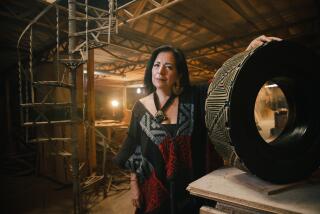O.C. Art Review : L.A.’s Energetic ‘Chicano Art’
- Share via
LAGUNA BEACH — Mexico’s indigenous art was ferociously intense--from its pre-Columbian temples to its heroic revolutionary muralists and satirical popular artists. Mexican American artists inherited this heartfelt engagement with the realities of the spirit but gave it their own twist.
The resulting aesthetic is seen in the Laguna Art Museum exhibition “Across the Street: Self-Help Graphics and Chicano Art in Los Angeles.” It surveys a local movement started more than two decades ago in some 70 prints by about 60 artists. It pays homage to the grass-roots, nonprofit workshop where they were produced.
Founded in 1972 by Franciscan nun and artist Karen Boccalero, East L.A.’s Self-Help Graphics has provided support and inspiration to a spectrum of artists. The museum acquired its entire run of 170 serigraphs and says it constitutes the largest public holding of Chicano prints. Museum curator Bolton Colburn organized the traveling exhibition and wrote the bilingual catalogue with contributions from Chicano art scholar Margarita Nieto.
The show is a valuable landmark in documentation of the movement. Its art looks funky on the surface but is remarkably consistent at bottom. Its slightly scruffy demeanor is undoubtedly a result of mixed artistic origins.
On one hand, it is the child of the pachuco era of the ‘40s. With their invention of the Zoot suit, lowrider car, distinctive dances and cool attitudes, the pachucos--according to Octavio Paz--set out to create a subculture that was neither Mexican nor American, but something outside. An early celebration of alienation, pachuco attitudes were those of the aesthetic dandy. They probably inspired the Beat generation. The pachucos’ real inheritors are today’s outlaw graffiti muralists.
The Chicano art movement provides a kind of domesticated bridge between the two. Early masters from Los Four, ASCO and East Los Streetscapers were university-trained. Artists like Carlos Almaraz, Gronk and Patssi Valdez absorbed the lessons of art’s mainstream. They brought to it the sense of social responsibility that animated Mexican artists like Jose Guadalupe Posada and the muralists. This extra-aesthetic goal was attached to the political and social aspect of the Chicano movement, symbolized by Cesar Chavez and the United Farm Workers. Almaraz, the art movement’s major hero, was torn between his sense of group responsibility and his desire to be a pure artist. Significantly, he never did a print with the workshop.
Self-Help Graphics inherited the idealistic ‘60s spirit that dwelt in prints by Sister Mary Corita and mainstream workshops like Tamarind and Gemini G.E.L. The Pop-era slogan of “Art for the People” seemed particularly possible of fulfillment in the multiple replication of the fine-print media.
Movements like Chicano art appeared parallel to other identity-based social rebellions, like feminism. At the time, the American Dream was still that of a melting pot into which everyone would be absorbed on merit. Exhibitions like this one bear sour witness to the failure of that dream. A small, self-absorbed art world has fractured into ever more tiny, self-referential cells.
At Laguna, there is a feeling the individual artist is subsumed to the group. Paradoxically, the technical excellence of the prints contributes to homogenization. They dip into varied aspects of a common style. If that manner resembles anything but itself, it looks like classic German Expressionism with its strident colors, busy surfaces, moral dedication and outraged satire.
Diane Gamboa’s “Malathion Baby” curtsies to E.L. Kirchner, then carries his sharded vision a step further. Victor Ochoa’s “Border Bingo” brings the subversive spirit of George Grosz to images from the dicey life of illegal border crossings. Valdez’s wonderfully moody green and turquoise “The Dressing Table” depicts a room with a private altar in the accents of the German “Bridge” group.
Could it be that this work has been mislabeled and really forms part of ‘80s Neo-Expressionism? Could it mean that people are really not so different from one another as they currently wish to believe?
There’s plenty of Mexican in Eduardo Oropeza’s Day of the Dead “Paradiso” and lots of American in Barbara Carrasco’s self-portrait as a marathon runner/artist about to be blotted out by a paint roller.
The ensemble may be less venturesome than possible, a bit too eager to fit in. It profits from sincere and energetic execution and from addressing human concerns that reach beyond any subculture. Like all living things, it derives vigor from crossbreeding.
* “Across the Street: Self-Help Graphics and Chicano Art in Los Angeles” is at the Laguna Art Museum, 307 Cliff Drive, Laguna Beach. Hours are Tuesday through Sunday, 11 a.m.-5 p.m. Through June 18. $3-$4. (714) 494-8971.
More to Read
The biggest entertainment stories
Get our big stories about Hollywood, film, television, music, arts, culture and more right in your inbox as soon as they publish.
You may occasionally receive promotional content from the Los Angeles Times.










